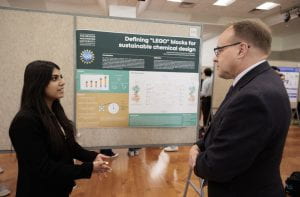The following blog post was written by fellow UHPer and Fall 2023 SURE Award recipient, Chaitrali Patil (Biology and Statistics, ’24). Read on about Chaitrali’s research and how she plans to utilize the SURE Award funding to further expand upon her experience!
The chemical industry and its advancements have played an imperative role in driving sustainable development and contributing to a higher quality of life for people. However, as a result of the commercialization of hazardous chemicals, the industry has also become the primary contributor to our two current and intertwined environmental crises: climate change and chemical pollution. The industry continues to rely on chemical and manufacturing technologies that are tied to fossil-fuel feedstocks, resulting in the generation of greenhouse gasses and chemicals that have adverse effects on human and environmental health. The industry possesses the means to rebuild a more innovative sector based on renewable and circular feedstock. To achieve such a desired change in developing next-generation chemicals that are high-performing, safe, and degradable, my research focuses on creating a new, virtual repository of biobased chemicals from natural and renewable feedstocks.
I will apply advanced statistical methods and programming languages, along with machine learning, AI, and other computational chemistry tools to develop a diverse set of novel pesticides with tunable properties that are better performing and less harmful than existing products. I will assess the efficiency and safety of the newly generated molecules by targeting their effects on acetylcholinesterase inhibition, the most common endpoint of existing insecticides, and comparing the results to pre-existing chemicals. Acetylcholinesterase is an essential enzyme for neuromuscular and central nervous system functioning, therefore, understanding the molecular mechanisms that disrupt the enzyme’s processes is key to both function (e.g. in insects) and toxicity (e.g., in fish or higher mammals). Additionally, this project will leverage the principles of green chemistry to propose synthetic processes to develop these novel molecules in a sustainable and green manner, considering factors such as waste (e-factor) and atom economy (conversion efficiency). Thus, the end product of my effort will be both a vast library of virtual compounds, which can be further used by the industry to develop safer chemicals across different functional classes, as well as a proof-of-principle case study on pesticides, showing a path to replacing existing active ingredients with better performing, sustainable alternatives.
The chemical industry is seeking radical change to achieve a more sustainable future, and this research, through the help of the SURE award, allows me to become a part of the process. The award will support and primarily alleviate some of the cost associated with the presentation of my research at the Society of Toxicology (SOT) National Conference in Salt Lake City, Utah in March 2024. Being able to present my research will allow me to share the progress I’ve made in the field of green chemistry pertaining to the redesigning of pesticides, gain perspective and advice from experts, and expand my professional network.




Interested in applying for your own SURE Award funding? Find out more about the application process here!
